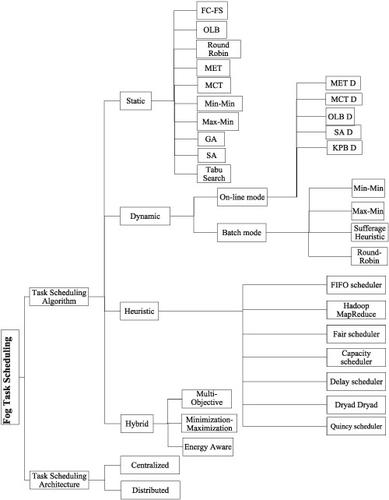当前位置:
X-MOL 学术
›
Int. J. Commun. Syst.
›
论文详情
Our official English website, www.x-mol.net, welcomes your
feedback! (Note: you will need to create a separate account there.)
Task scheduling approaches in fog computing: A systematic review
International Journal of Communication Systems ( IF 1.7 ) Pub Date : 2020-08-16 , DOI: 10.1002/dac.4583 Mohammad Reza Alizadeh 1 , Vahid Khajehvand 1 , Amir Masoud Rahmani 2 , Ebrahim Akbari 3
International Journal of Communication Systems ( IF 1.7 ) Pub Date : 2020-08-16 , DOI: 10.1002/dac.4583 Mohammad Reza Alizadeh 1 , Vahid Khajehvand 1 , Amir Masoud Rahmani 2 , Ebrahim Akbari 3
Affiliation

|
The Internet of Things (IoT) interconnects billions of physical objects to collect and exchange information and makes available various applications. Despite all the advantages of the IoT, some of its applications are not feasible because of the existing restrictions in the IoT sensors. To overcome these restrictions, cloud computing has been developed in recent years. Although cloud computing has removed some of these restrictions, the cloud itself has faced some other challenges. One of these challenges is the distance between the cloud and the end‐devices, which is not ideal for delay‐sensitive applications and also leads to high communication costs and security problems. To handle these challenges, the fog computing has been introduced in literature, which places the resources and services at the edge of the network, close to the end‐devices. On the other hand, fog nodes suffer from heterogeneity, uncertainty, and dispersion of resources, and also processing, storage, and memory limitations. Thus, there is need for a proper task scheduling approach to use these resources optimally. In this study, the task scheduling algorithms proposed by different researchers for the cloud‐fog environment, their advantages and disadvantages, and also various tools and issues regarding the scheduling methods and their restrictions were discussed. The results indicated that about 58% of the scheduling algorithms use static scheduling and that the other 42% use dynamic scheduling, and the delay metric is the most noteworthy parameter considered in most studies with a share of nearly 17%. Finally, we identified the open issues related to the task scheduling based on cloud‐fog computing and provided some directions for future works.
中文翻译:

雾计算中的任务调度方法:系统综述
物联网(IoT)互连数十亿个物理对象,以收集和交换信息并提供各种应用程序。尽管有物联网的所有优点,但由于物联网传感器的现有限制,其某些应用仍不可行。为了克服这些限制,近年来已经开发了云计算。尽管云计算消除了其中一些限制,但是云本身还面临其他挑战。这些挑战之一是云与终端设备之间的距离,这对于延迟敏感的应用程序不是理想的选择,还会导致高昂的通信成本和安全性问题。为了应对这些挑战,文献中已经引入了雾计算,将雾和资源放置在网络边缘,靠近终端设备。另一方面,雾节点遭受异构性,不确定性和资源分散以及处理,存储和内存限制的困扰。因此,需要适当的任务调度方法来最佳地使用这些资源。在这项研究中,讨论了不同研究人员针对云雾环境提出的任务调度算法,其优缺点以及与调度方法及其限制有关的各种工具和问题。结果表明,约58%的调度算法使用静态调度,而其他42%的调度使用动态调度,而延迟度量是大多数研究中最值得关注的参数,所占比例接近17%。最后,
更新日期:2020-10-05
中文翻译:

雾计算中的任务调度方法:系统综述
物联网(IoT)互连数十亿个物理对象,以收集和交换信息并提供各种应用程序。尽管有物联网的所有优点,但由于物联网传感器的现有限制,其某些应用仍不可行。为了克服这些限制,近年来已经开发了云计算。尽管云计算消除了其中一些限制,但是云本身还面临其他挑战。这些挑战之一是云与终端设备之间的距离,这对于延迟敏感的应用程序不是理想的选择,还会导致高昂的通信成本和安全性问题。为了应对这些挑战,文献中已经引入了雾计算,将雾和资源放置在网络边缘,靠近终端设备。另一方面,雾节点遭受异构性,不确定性和资源分散以及处理,存储和内存限制的困扰。因此,需要适当的任务调度方法来最佳地使用这些资源。在这项研究中,讨论了不同研究人员针对云雾环境提出的任务调度算法,其优缺点以及与调度方法及其限制有关的各种工具和问题。结果表明,约58%的调度算法使用静态调度,而其他42%的调度使用动态调度,而延迟度量是大多数研究中最值得关注的参数,所占比例接近17%。最后,











































 京公网安备 11010802027423号
京公网安备 11010802027423号